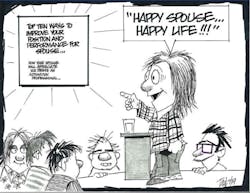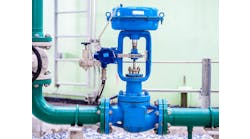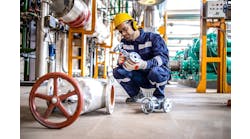This Control Talk column appeared in the August 2019 print edition of Control. To read more Control Talk columns click here or read the Control Talk blog here.
Greg: One of our primary objectives in this column is to show straightforward solutions developed by practitioners that address the hearts of the challenges to get the best out of the control system and consequently, your process. Here, we show how to first greatly increase the rangeability and sensitivity of control valves, then optimize the process by simple addition of one or more PID controllers, without any additional hardware or software. Often, it’s a configuration change that can be done in a matter of days once you understand what’s truly needed, which is our goal here. We start with George Buckbee, who has considerable experience in process control and is currently an outstanding source of getting the most out of your PID, as seen in his many presentations and papers. George is an ISA Fellow and author of the focused book, “Mastering Split Range Control.” He heads up the Performance Solutions group at Metso.
Valve position control and override control can greatly improve your valve and process performance. You can achieve these results without creating oscillations, upsetting other loops or interfering with the primary process PID controller’s ability to do its job. The challenges addressed are valve stiction and backlash, installed flow characteristic, interactions, disturbances and improper tuning of optimized and related PID controllers.
George, how do you implement valve position control?
George: Addition of valve position control (VPC) is an excellent method to obtain accurate and precise control, even over a wide range of operation. With regular PID and a single valve, it can be difficult to control precisely. Control valves can exhibit stiction, backlash and other nonlinearities that can vary over the full range of operation.
One common scenario involves two controllers, one manipulating the large valve, and one manipulating the small valve. The small valve is configured as a normal PID control loop, to control the measured process variable to its setpoint. A second controller, with a large valve, becomes the valve position controller, or VPC. In this second controller, the signal to the small valve is supplied as the process variable (controlled variable). The setpoint is generally set to its most desired throttle position. In this way, the second controller is adjusting the process flow to keep the small, precise valve near the middle of its best range of operation. For sliding stem valves, the setpoint is about 50%, but for rotary valves, it may be 30% due to flattening of the installed flow characteristic above 60 degrees of rotation.
This arrangement has several advantages over standard PID control. First, the effective range of operation under precise control can be increased dramatically by moving the small valve for small disturbances and only moving the large valve to keep the small valve in a good throttle range. This solution is much better than split-range control, where you end up trying to move the big valve most of the time. Since backlash and stiction are a percent of valve capacity, moving the small valve is much more precise. Also, the small valve can more likely be a sliding stem valve with a diaphragm positioner that has a much smaller percent backlash and stiction than a rotary valve with a piston actuator, which is often used for the large valve. Plus, you avoid the discontinuity and nonlinearity at the split-range point. Most processes tend to oscillate at the split-range point.
Greg: What PID structure and tuning rules do you use for valve position control?
George: The primary controller, with the small valve, does most of the work, moving quickly to keep the process stable and in-control. The VPC moves much more slowly. Its goal is to keep the primary controller in a good control range. The primary controller should be tuned to be fast responding. Aggressive tuning, with PI or PID methods, should be used. The VPC should be tuned more loosely, with P-only, PI or I-only control, to avoid interaction. The VPC should be at least five times slower than the primary controller. This can be done many ways, using Lambda tuning, by matching frequency responses, or using methods such as Relative Response Time.
There may be other considerations, such as a desire to limit movement of a large valve by the VPC. In one case, we were trying to extend valve life by limiting the movement of a 48-inch valve that was remotely located on an island. You can reduce travel using P-only control, or, if the process allows, implementing a gap action VPC.
Greg: There are several VPC challenges to be addressed. Valve backlash and stiction is particularly an issue for the big valve being manipulated by the VPC. Big valve movement can be suppressed by adaptive tuning where the gain is nearly zero for a tolerable offset from VPC setpoint (e.g., gap action). Backlash can be compensated by an increment and decrement equal to the deadband for a change in signal direction that is positive and negative, respectively. You are stuck with stiction. However, in addressing another challenge—large disturbances (potentially causing the primary controller manipulating the small valve to run out of valve)—by adding a feedforward signal to the VPC output to preemptively position the large valve, you can increase the gain for small changes in feedforward signal to get it through the resolution limit. The positioners for both valves should not use integral action and should be tuned with aggressive proportional action to minimize deadband and the resolution limit seen by the VPC. External-reset feedback (e.g., dynamic reset limit) can be turned on in the VPC to stop limit cycles if there is a good readback of actual final closure element position (e.g., actual plug, ball or disk position). Note that shaft position feedback is often not a good indicator of actual ball or disk position for rotary valves designed for tight shutoff due to high seal friction and backlash in ball- or disk-to-stem and in stem-to-actuator-shaft. Balls or disks with integrally cast stems and splined stem-to-shaft connections can minimize the backlash from shaft windup. See the Control Talk feature article “How to specify valves and positioners that don’t compromise control” to avoid this increasing problem due to the emphasis on capacity, leakage and cost and not valve response.
Signal characterization applied to each PID output should be used to linearize the installed flow characteristic, which tends to be quite nonlinear for rotary valves. This helps feedback and feedforward control. Tuning of the VPC is still a challenge even after linearization of valves because any change initiated by the VPC has to work through the primary PID closed-loop response before it is seen as the corresponding change in the small valve position that is the controlled variable of the VPC. Thus, the VPC tuning depends upon the primary PID tuning besides the open-loop response of the process. This means the primary PID should be tuned first to provide a fast response. The VPC is then tuned to provide a closed-loop response at least five times slower than the primary PID. This can correspond to the VPC lambda being five times the primary PID lambda. For near-integrating and true integrating processes, the lambda is an arrest time (time to stop a process excursion from a load disturbance on process input). In a way, these rules about tuning the lower loop first for a fast response and then tuning the upper loop for a five times slower smooth response is similar to that for cascade control. However, in the VPC case, tight control in the upper VPC loop is not important. If a positioner or primary PID is retuned, the VPC must be retuned.
In general, the VPC goal is a smooth, gradual optimization with a fast getaway for abnormal conditions. Feedforward and nonlinear adaptive tuning (e.g., higher VPC gain as the small valve approaches the end of the desired throttle range) can be used to help prevent running out of small valve. Directional velocity limits—by putting different up and down setpoint rate limits on what the VPC is manipulating, and turning on external-reset feedback (e.g., dynamic reset limit)—is a powerful tool.
There are many applications where VPC can optimize a process by pushing a primary PID control valve to a maximum or minimum throttle position with room to maneuver. In nearly all cases, the signal to the valve being pushed to limit can be used instead of the actual valve position as the controlled variable of the VPC. Note that if signal characterization is applied to the VPC output, the valve signal is the characterizer output. The article “Don’t Overlook PID in APC” (Control, Nov. ’11, p. 39) provides significant guidance on how prime mover, chiller and cooling tower energy, purchased fuel and reagent costs can be minimized, and how reactor and column production rates can be maximized.
The ability to handle abnormal conditions by directional velocity limits, feedforward and adaptive tuning is greater for these applications because, in most cases, valves are being pushed to be as far open or closed as possible without interfering with the ability of the primary PID to provide tight control.
When there is more than one valve position to be optimized, such as several downstream feed valves or pressure and temperature valves, override control is used by having the multiple VPC outputs as inputs to a signal selector whose output is the upstream primary PID setpoint that is being optimized. If the setpoint is being maximized and minimized, low and high signal selectors are used, respectively. The override controllers should use external-reset feedback so integral action is suspended until the VPC is selected. Positional algorithms for override control are recommended by Harold Wade so that point of takeover is determined by the position of the override PID PV relative to its effective proportional band set by PID gain. For much more on override control and the PID algorithm functionality and capability, including reset windup, see Harold Wade’s ISA book, Basic and Advanced Regulatory Control - System Design and Application, Third Edition and Karl Astrom’s and Torre Hagglund’s ISA book, Advanced PID Control.
Override control is sequential in that only one override controller is selected at a time. For simultaneous optimization, more complex process performance goals, and better handling of interactions and disturbances, model predictive control (MPC), with its linear program optimizer, should be considered. However, MPC requires special software and expertise. The quicker and less expensive solution is generally VPC and override control, which can be the starting point to justify a more extensive and intelligent solution by MPC. For more on the practical considerations with PID control, see my Momentum Press book, Tuning and Control Loop Performance, Fourth Edition, and for a comprehensive look at what makes an application successful, see the McGraw-Hill 2019 Process/Industrial Instruments and Controls Handbook, Sixth Edition, capturing the expertise of 50 leaders in industry.
(10) Put what you do in the best position to help your spouse do the best thing.
(9) If you see a situation coming, be proactive by taking corrective action before it becomes a problem.
(8) Make sure anything you do is smooth, minimizing backlash and sticky behavior.
(7) Don’t interfere with what your spouse needs to do.
(6) Sense and act on the direction of change in your spouse’s needs.
(5) Sense and act on the speed of change in spouse’s needs.
(4) Don’t keep changing if your spouse is about to be satisfied and reach an equilibrium.
(3) Realize there are possibly several different situational problems and select to act on the most severe.
(2) Optimize goals continuously with significant feedback.
(1) React quickly to hurtful conditions.







